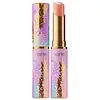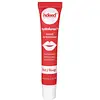What's inside
What's inside
 Key Ingredients
Key Ingredients

 Benefits
Benefits

 Concerns
Concerns

 Ingredients Side-by-side
Ingredients Side-by-side

Polybutene
Simmondsia Chinensis Seed Oil
EmollientPunica Granatum Sterols
Skin ConditioningDiisostearyl Malate
EmollientPolyethylene
AbrasiveC12-15 Alkyl Lactate
EmollientOctyldodecanol
EmollientIsostearyl Hydroxystearate
EmollientTriisostearyl Citrate
EmollientTrimethylolpropane Triisostearate
EmollientCandelilla Cera
EmollientTridecyl Trimellitate
EmollientEthylhexyl Palmitate
EmollientHydrogenated Polycyclopentadiene
Mentha Piperita Oil
MaskingPhenoxyethanol
PreservativeTribehenin
EmollientTetrahexyldecyl Ascorbate
AntioxidantTocopheryl Acetate
AntioxidantSorbitan Isostearate
EmulsifyingSilica Dimethyl Silylate
EmollientAstrocaryum Murumuru Seed Butter
EmollientTheobroma Grandiflorum Seed Butter
Skin ConditioningCocos Nucifera Oil
MaskingButylene Glycol
HumectantSodium Hyaluronate
HumectantAlgae Extract
EmollientLimonene
PerfumingLinalool
PerfumingGardenia Taitensis Flower Extract
Skin ConditioningTocopherol
AntioxidantPalmitoyl Tripeptide-1
Skin ConditioningCI 15850
Cosmetic ColorantCI 77891
Cosmetic ColorantCI 77491
Cosmetic ColorantPolybutene, Simmondsia Chinensis Seed Oil, Punica Granatum Sterols, Diisostearyl Malate, Polyethylene, C12-15 Alkyl Lactate, Octyldodecanol, Isostearyl Hydroxystearate, Triisostearyl Citrate, Trimethylolpropane Triisostearate, Candelilla Cera, Tridecyl Trimellitate, Ethylhexyl Palmitate, Hydrogenated Polycyclopentadiene, Mentha Piperita Oil, Phenoxyethanol, Tribehenin, Tetrahexyldecyl Ascorbate, Tocopheryl Acetate, Sorbitan Isostearate, Silica Dimethyl Silylate, Astrocaryum Murumuru Seed Butter, Theobroma Grandiflorum Seed Butter, Cocos Nucifera Oil, Butylene Glycol, Sodium Hyaluronate, Algae Extract, Limonene, Linalool, Gardenia Taitensis Flower Extract, Tocopherol, Palmitoyl Tripeptide-1, CI 15850, CI 77891, CI 77491
Polybutene
Hydrogenated Poly(C6-14 Olefin)
EmollientCaprylic/Capric Triglyceride
MaskingButyrospermum Parkii Butter
Skin ConditioningPunica Granatum Sterols
Skin ConditioningIsosorbide Disunflowerseedate
HumectantEuphorbia Cerifera Wax
Hydroxystearic Acid
CleansingMangifera Indica Seed Butter
Skin ConditioningTocopheryl Acetate
AntioxidantEthylhexyl Palmitate
EmollientCetearyl Ethylhexanoate
EmollientPolyethylene
AbrasiveSilica Dimethyl Silylate
Emollient1,2-Hexanediol
Skin ConditioningCaprylyl Glycol
EmollientStearic Acid
CleansingTetrahexyldecyl Ascorbate
AntioxidantSorbitan Isostearate
EmulsifyingCarthamus Tinctorius Seed Oil
MaskingPalmitic Acid
EmollientPortulaca Pilosa Extract
Skin ConditioningTrihydroxystearin
Skin ConditioningSucrose Cocoate
EmulsifyingCamellia Oleifera Leaf Extract
AstringentCoffea Arabica Seed Extract
MaskingEuterpe Oleracea Fruit Extract
Garcinia Mangostana Fruit Extract
Skin ConditioningLycium Barbarum Fruit Extract
AstringentMorinda Citrifolia Fruit Extract
Skin ConditioningPunica Granatum Extract
AstringentSodium Hyaluronate
HumectantPalmitoyl Tripeptide-38
Skin ConditioningGlucomannan
Skin ConditioningCI 73360
Cosmetic ColorantCI 15850
Cosmetic ColorantPolybutene, Hydrogenated Poly(C6-14 Olefin), Caprylic/Capric Triglyceride, Butyrospermum Parkii Butter, Punica Granatum Sterols, Isosorbide Disunflowerseedate, Euphorbia Cerifera Wax, Hydroxystearic Acid, Mangifera Indica Seed Butter, Tocopheryl Acetate, Ethylhexyl Palmitate, Cetearyl Ethylhexanoate, Polyethylene, Silica Dimethyl Silylate, 1,2-Hexanediol, Caprylyl Glycol, Stearic Acid, Tetrahexyldecyl Ascorbate, Sorbitan Isostearate, Carthamus Tinctorius Seed Oil, Palmitic Acid, Portulaca Pilosa Extract, Trihydroxystearin, Sucrose Cocoate, Camellia Oleifera Leaf Extract, Coffea Arabica Seed Extract, Euterpe Oleracea Fruit Extract, Garcinia Mangostana Fruit Extract, Lycium Barbarum Fruit Extract, Morinda Citrifolia Fruit Extract, Punica Granatum Extract, Sodium Hyaluronate, Palmitoyl Tripeptide-38, Glucomannan, CI 73360, CI 15850
Ingredients Explained
These ingredients are found in both products.
Ingredients higher up in an ingredient list are typically present in a larger amount.
Ci 15850 is the pigment color red. It is an azo dye and created synthetically.
Azo dyes need to be thoroughly purified before use. This allows them to be more stable and longer-lasting.
This ingredient is common in foundations, lipsticks, and blushes. This color is described as brown/orangey red.
It has many secondary names such as Red 6 and Red 7. According to a manufacturer, Red 6 usually contains aluminum.
Learn more about CI 15850Ethylhexyl Palmitate, also known as octyl palmitate, is created from 2-ethylhexyl alcohol and palmitic acid. It is a fatty acid ester.
The fatty acid content of Ethylhexyl Palmitate makes it an emollient. Emollients help soften and hydrate your skin by trapping moisture within.
Ethylhexyl Palmitate is also used to help improve the texture of cosmetics. It helps other ingredient dissolve in products and help disperse ingredients more evenly.
You'll likely find this ingredient in sunscreen, as it is often used to mix UV-blocking ingredients such as avobenzone and ethylhexyl triazone.
It can also help stabilize the fragrances in a product as a fragrance fixative.
Ethylhexyl Palmitate can be used to substitute mineral oil.
Due to its high fatty acid content, it may not be fungal-acne safe.
Learn more about Ethylhexyl PalmitatePolybutene is used to help control the viscosity of a product. This just means it helps adjusts the texture.
It is a polymer and does not get absorbed into the skin due to its large size.
Studies found this ingredient did not irritate skin in concentrations below 15%.
Learn more about PolybutenePolyethylene is a synthetic ingredient that helps the skin retain moisture. It is a polymer.
It is also typically used within product formulations to help bind solid ingredients together and thicken oil-based ingredients. When added to balms and emulsions, it helps increase the melting point temperature.
Punica Granatum Sterols isn't fungal acne safe.
This silica is mainly used to thicken oils and suspend particles in oils. It is not water soluble.
According to the manufacturer, it:
The manufacturer also claims this ingredient to be useful in makeup.
In lipstick formulations, this ingredient improves color payoff, reduces pigment settling, and reduces oil bleeding. This ingredient also improves the grip of powder products such as dry shampoos.
Learn more about Silica Dimethyl SilylateSodium Hyaluronate is hyaluronic acid's salt form. It is commonly derived from the sodium salt of hyaluronic acid.
Like hyaluronic acid, it is great at holding water and acts as a humectant. This makes it a great skin hydrating ingredient.
Sodium Hyaluronate is naturally occurring in our bodies and is mostly found in eye fluid and joints.
These are some other common types of Hyaluronic Acid:
Learn more about Sodium HyaluronateSorbitan Isostearate is an emulsifer and cleaning agent. It is created from isostearic acid and sorbitol.
As an emulsifier, Sorbitan Isostearate prevents oils and water from separating.
Due to its isostearic acid base, it may not be safe for Malassezia or fungal acne.
Learn more about Sorbitan IsostearateTetrahexyldecyl Ascorbate (THD) is a stable and oil-soluble form of Vitamin C.
THD is special in that it has the ability to travel deeper into skin than traditional ascorbic acid while maintaining the same skin benefits (double win!).
Because it’s oil-soluble, THD dives deep into your skin’s fatty layers (think ceramides and cholesterol) to fight off the kind of free radicals that mess with your skin barrier. This makes it a great pair with water-based vitamin C (ascorbic acid) that mainly works on the surface.
Even at just 0.1%, THD is already showing great antioxidant activity. When used up to 2%, it helps keep your skin happy and calm, especially when it’s stressed from pollution or sun.
Want to fade dark spots or tackle hyperpigmentation? You’ll want 5% or more. Pairing it with brightening buddies like niacinamide or licorice root gives even better results. One study even used 30% THD with other brighteners and saw real results on stubborn discoloration, even in melasma-prone skin.
A note on THD: It’s has a slightly silky, oily texture and usually shows up colorless or pale yellow (though the exact shade can vary by supplier).
While you can sneak it into water-based formulas, it really shines when paired with silicones or oils, which help your skin soak it up better.
THD is pretty stable, but it’s still vulnerable to degradation like ascorbic acid. Too much light or heat (above 113°F / 45°C) can break it down over time. Go for dark and opaque packaging that keeps it safe and shady!
Read more about other types of Vitamin C:
Learn more about Tetrahexyldecyl AscorbateTocopheryl Acetate is AKA Vitamin E. It is an antioxidant and protects your skin from free radicals. Free radicals damage the skin by breaking down collagen.
One study found using Tocopheryl Acetate with Vitamin C decreased the number of sunburned cells.
Tocopheryl Acetate is commonly found in both skincare and dietary supplements.
Learn more about Tocopheryl Acetate